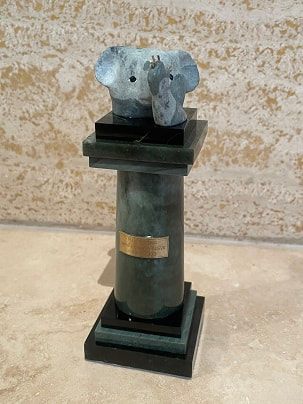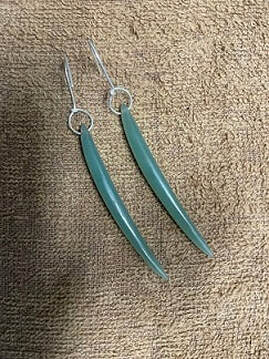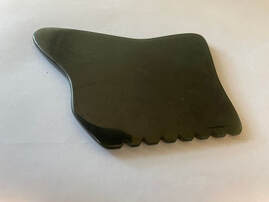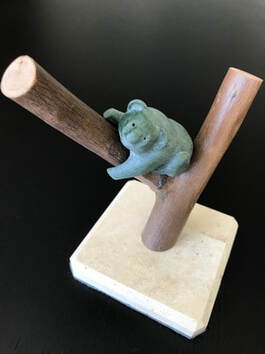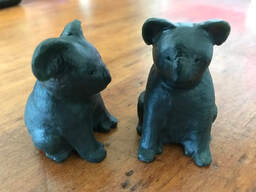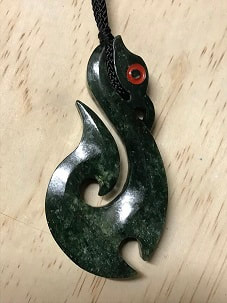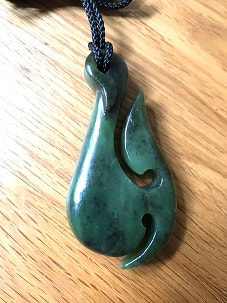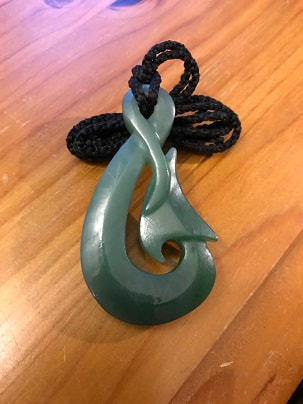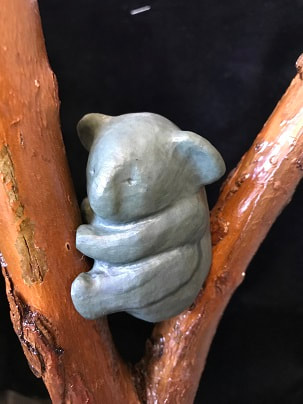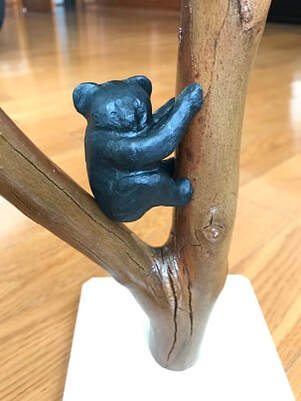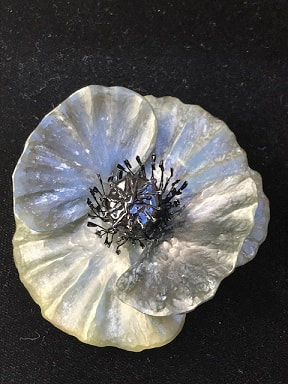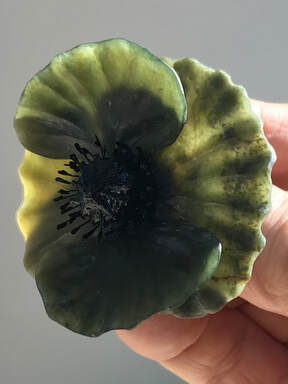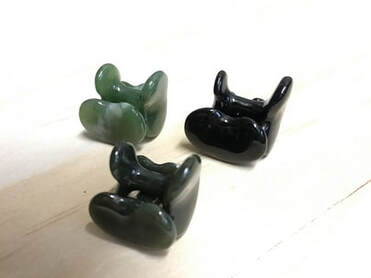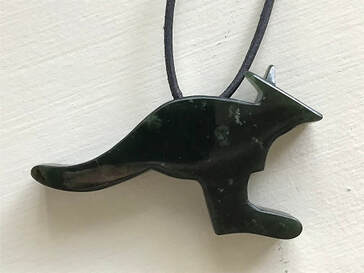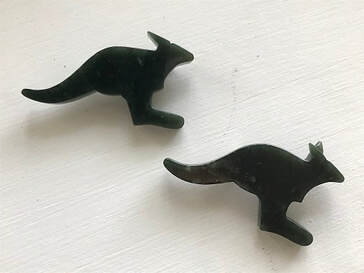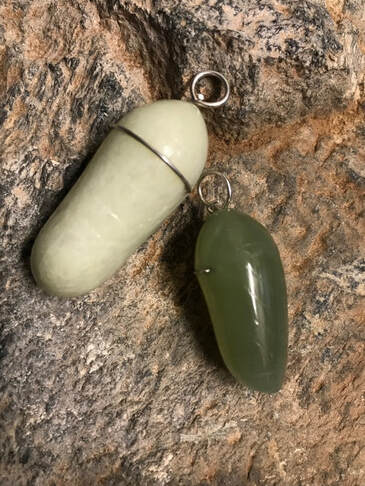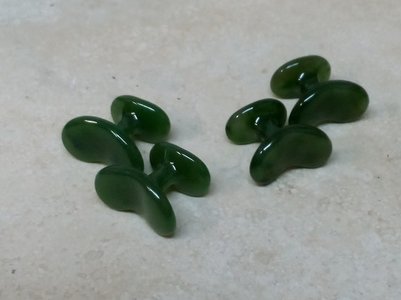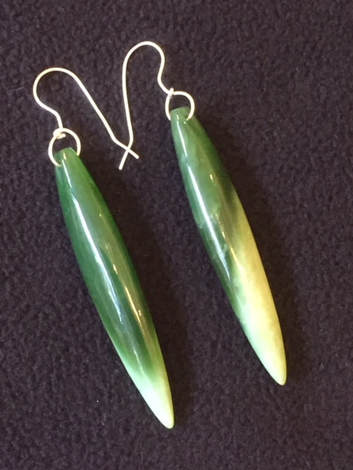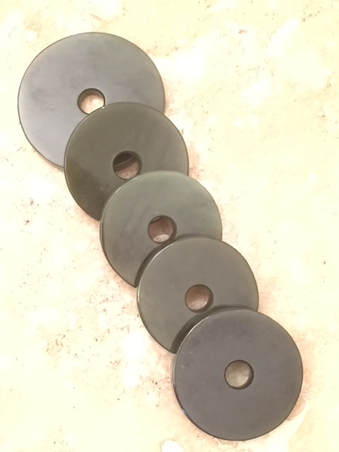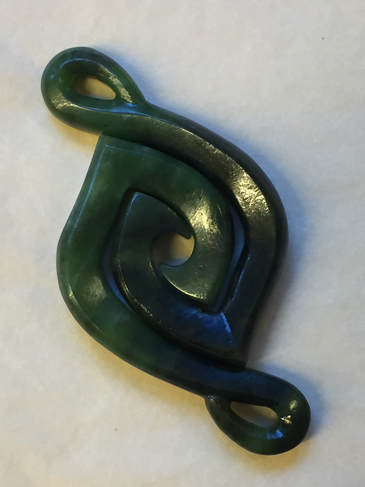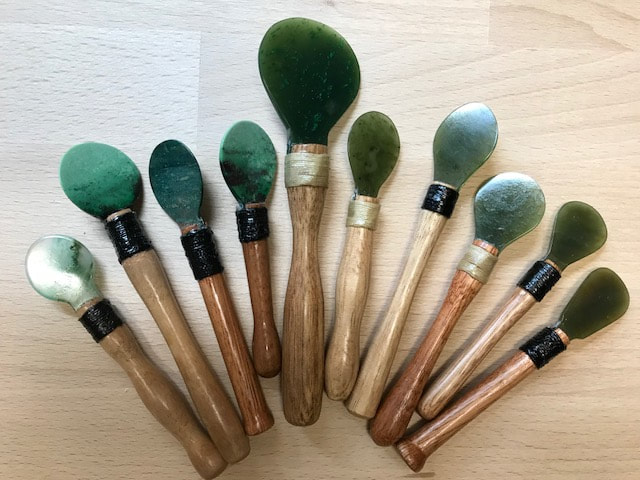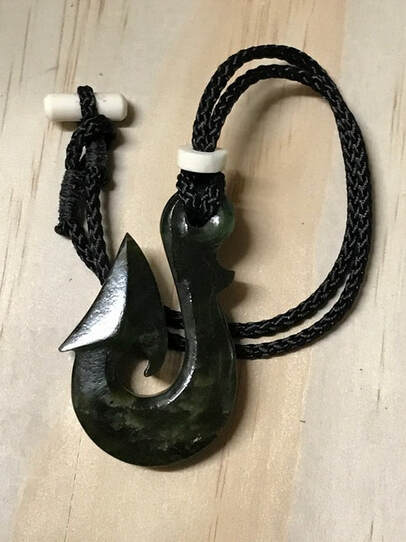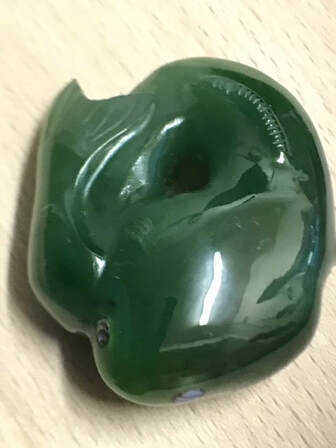Koala bust on a pedestalThis is a piece I've been working on for a number of years, just finished in time to enter it into a local small sculptures exhibition, if it is approved-of by the judges.
It is made out of a variety of pieces of Cowell, which show off the range of colours and textures to be found. It is 155 mm high by a maximum of 55 mm square, and features, as you can see, the head and front leg of a koala. The paw is raised in indignation and the plaque reads, "RIP the last wild koala in NSW - died 2033". This is sadly a prophesy at current trends, to the point that the state government has recently placed them on the "Endangered" list. This is tragic! The decline in numbers is due to a variety of factors: habitat loss caused by building developments and an occasional coal mine, road deaths and harrying by dogs (which are more likely today as their habitat is broken up forcing them to travel along the ground between suitable areas) and of course the felling of trees by landowners for farming. And sadly, we need to mention the part played by recent bushfires, which points to another area of concern - land management. Anyway, off my hobbyhorse and just to add that the base, shaft and capital are polished to show off the beauty of the stone. The head and leg have been left rough because the stone is close to the right colour for koalas in that state. I've added glass eyes, a brass plaque (engraved for me by Mister Minit) and some brass weeds at the back of the column, signifying neglect, which is exactly how this precipitous situation has come about. I hope urgent steps will be taken to end their decline and enlarge their habitat over the coming years. What would NSW be without wild koalas? Much poorer. |
Inanga earringsI was asked to make a pair of earrings similar to those in a picture the lady provided. Trying to match the contours and thickness of something in a picture is not always easy but I think it worked.
And in the process I needed to tape my fingertips to prevent losing nails and skin on the coarse lap! But hey, we thrive on such things, right? The design was similar to the traditional recurved earrings worn by Maoridom in the past. The stone is beautiful South Westland inanga and a pleasure to work. The silver-work was easy, using a simple wood and pin guide. The result was satisfying. What more can I say? |
Gua sha toolI love commissions - they take me to places I'd never imagine! A lady kindly asked me to make her a gua sha tool for her business (gua sha is a traditional Chinese treatment to remove toxins from the skin and to invigorate the person's organs as I understand it). On a tool which is going to be rubbed over the skin, smoothness is important, and rounded edges are the order of the day. It was carved from a slab of lovely Cowell and reminded me of my lapping techniques.
|
And another koala!A friend didn't want his koala sitting on the ground: I'd seen a picture of one lolling lazily on a branch, one front leg dangling, which I used as a guide. I needed to make a clay model to get the neck right, and this saved the day. The carving uses beautiful Cowell, and I only saw the stone was chatoyant when I started to clean up the carving with finer grades of grit - a real bonus!
The "tree" is of Aussie gum, dried, and finished with matt varnish, and the base is a piece of a Travertine floor tile scavenged from a builder's skip many years ago. I knew the offcuts would come in handy some day! I carved this during July - August 2021, during the Sydney COVID lockdown. I can see I'll have time to complete a couple more before we are all released into the community again. There's always a silver lining, if you look hard enough! I'm happy with the result, not that the next one won't be even better of course! So please, watch this space! |
A brace of koalasI have some back-orders for koalas and decided to produce a batch to a more down-to-earth design (pun intended), which were quicker to produce than the tree-bound ones. Sadly there was a third in the batch but I was a bit mean with the stone size and had to abort that one, which will shortly become a wombat. The one on the left represents a younger animal, whilst the other is of a leaner, older one.
I read and hear of the declining numbers of koalas in the wild with sadness and ask that all affected governments urgently address the factors which are leading to their population decline. On a somewhat lighter note, they are, of course, carved from some beautiful Cowell which I purchased the last time I was at the mine. I shall be returning to koalas in a couple of months once I've produced some very different carvings so please watch this space! |
Manaia & matauTwo more pieces I completed recently are the manaia and matau shown here.
The manaia was carved from beautiful Marsden. Although it is coarsely crystalline throughout, it ground down evenly and gave a pleasing finish. Maybe it was a bit friable for the detail I wanted to include and some crystals dislodged along some of the sharp edges. But that was my fault and not the stone's! Overall it is a pleasing piece with the cord imitating a bridle and the experimental eye, which together "make" it in my view. The second picture shows a pretty chunky matau. It's the detail which makes it though. The cord-closure overlying the stem of the piece gave me all sorts of work but upon cleaning up it looks great! The South Westland kawakawa is tricky to work because it is so heterogenous. The dark, opaque patches were softer than the mid-green, semi-translucent parts: most of the latter had a swirling texture where fluids had been passing through the mass of the stone, causing it to melt unevenly and crystallise with variable hardness and toughness. They are a fine pair and offer due homage to the Maori carvers who have made these forms through the centuries. |
Inanga hei matauIt's been a long time since I carved a batch of Maori-inspired pieces. Too long! I began to make amends a month or so ago with a small batch of pieces which I designed to be more technically challenging than anything similar that I'd previously carved. I think I've achieved this.
A couple of days ago I was approached by a lady who noticed the hei matau I was wearing and wanted something similar. As chance would have it, I showed her a picture of the unfinished piece (at left) in the workshop, which she loved. The stone is some beautiful South Westland inanga. It darkens towards the bottom, and has some contorted flow banding running through it. It is 12 mm thick and 70 mm from top to bottom, a little larger than the majority of pieces in the shops. It has a good weight. As it was already partly formed it only took a couple of days to clean it up and polish it. I delivered it today. Now I need to finish the others in the batch! |
Cowell koalasIt was about time I tried my hand at carving koalas. And they are quite a tricky shape to carve I found out - I spent hours studying pictures of the animals!
The top picture shows the first I made. It represents a young animal with a large head in relation to it's body, made to look larger because it was slumped into the fork of a tree, and quite sleepy, as they often are. The lower picture shows a rather trickier pose by a mature koala. With the front legs relatively thin, one fracture more than I'd noticed and worked around could have spelt disaster, but I was thorough, or lucky! Of course they are carved from Cowell and the two koalas show the variation in the stone. The upper picture shows a piece of grayish-green jade with some darker banding. These bands are where the fluids, due to partial melting of the nephrite during formation, had flowed. The lower one is made from stone which is close to "Black" and had melted and completely recrystallised during formation. Each koala is shown seated in a forked piece of eucalypt which is varnished, and then screwed to the base of a square of Travertine tile. Judging by the interest from friends I will be making a lot more koalas in the coming years and it will be interesting to see how the designs change over time. |
Remembrance poppyI was asked to make a remembrance poppy in jade and after much thought and an illuminating talk with the gentleman concerned, came up with the piece shown here. It was a complete departure from my Maori carving style because I wanted to show the hidden beauty of the stone (lower figure), and to do that I needed to grind the petals thinly, which required them to be made from separate pieces of stone.
The poppy has been a symbol of remembrance for the armed services since the Great War. I chose the form of a still-opening flower as a metaphor for the youth of many of the men and women who have been killed whilst defending our country. I also chose four different pieces of Cowell to represent, as far as I could, the diversity of those lost. Having ground-down the petals to a point where the inner beauty could be seen in transmitted light (lower figure), I finished them with grinding sticks to create a patina and polished highlights (upper figure). I then set-about forming the pistil by turning-down a piece of dowelling to shape and size, then adding the stigma, made from cord on the top. The stamens are made from thin copper wire bent to produce the anthers. They were fixed into the pistil and painted. And finally the petals were fixed in place. As far as my continuing development as a carver is concerned, this is one of the most significant pieces I’ve carved in a few years. I am happy I fulfilled the terms of the commission (except the initial timeframe!) and will be doing more work in this vein in the future as I feel it honours the stone I am working in the best way I can. I finished this piece in early June 2020. |
Beautiful nephrite!A further order for jade cufflinks pushed me into finishing off a couple of pairs I'd started some time ago as well as making two new pairs. In the picture on the left you can see the beautiful shades of jade. Top left is a piece of highly translucent mid-green Yukon nephrite with some white flecking. Front is dark green and highly translucent Cowell. And at top right is a pair made from Cowell Black.
It was interesting to see how they polished-up. The Black was hard and generally took longest; the Yukon was softer and took least time. But you don't get something for nothing - getting the perfect polish on the Black seemed to take forever! |
Aussie icons - kangaroosThey've been a long time coming but I've finally got around to carving the first of a series of designs that I am calling Aussie icons. These kangaroos had to be the first ones, although I did carve some gumleaves when I lived in Canada some years ago. I was probably homesick!
These three are carved out of Cowell nephrite of course! It's a dark green with moderate translucency, and you can see there are minor white markings in the stone which remain from when the stone cooled one and an half billion years ago. The top one is a pendant, on a thick leather thong. The bottom pair are brooches. They are all the same size because I cut out the blank before separating them from each other, but the brooches are thinner and lighter than the pendant. And they are all different in the details. |
Monarch chrysalidesI finished this pair of Monarch butterfly chrysalides (plural of chrysalis - I had no idea until I checked recently!) in May 2019. They came about as the result of a request by a lady in Toronto who asked me some years ago if I could make her one.
The one on the left is made from beautiful, pale yellowy-green Swiss nephrite. It is quite soft with a slightly granular texture which together, affected my ability to obtain a polished finish. The one on the right is made from gorgeous, high translucency serpentine. I have no idea where it's from unfortunately. It is also fairly soft. Carving the shape was relatively simple. Trying to decide which detail to engrave on the surface was an interesting exercise! The major feature on them is a black & yellow ridge around half of the body. I decided to represent this with a fine silver wire, drilled and glued in place. And in case you are wondering, the head is at the bottom! |
One-piece cufflinks
The wonderful thing about taking commissions is you never know what will be asked for next! Some I have to turn down, but I received a request for cufflinks last year, each made from a single piece of nephrite, which took me along a hitherto untrodden pathway.
Technically they were not difficult. I needed to use good quality stone, and chose pieces from the Cassiar mine (on the left) and Polar mine (on the right) - both in northern BC, Canada. What took the majority of time was cleaning up and polishing them as there isn't a single flat surface on them. You can't rush this process! The Cassiar stone is lovely - it has bright green flecks of chrome in it that light it up! I bought the Polar (some call it "the queen" of BC nephrites) from George Vanderwolf in Lillooet in 2012 - he's one of a dying breed of men and I was happy to make his acquaintance. It also has some chrome flecks in it, but is slightly darker and more translucent in relation to the particular piece of Cassiar I used here. As you can see they came to a beautiful, mirror finish, and whilst they took a lot longer than anticipated to complete (not helped by an ankle reconstruction along the way), I am very happy with the final results. As was the new owner - he ordered two more pairs! |
Banded inanga ear-rings
Some years ago Buddy kindly gave me a gorgeous piece of South Westland inanga from which I made a few pieces. It has a centre of beautiful deep, clear greens, surrounded by a band of translucent dark green, and then a weathered exterior rind of pale milky greens shading to white - you can see the progression clearly in the right-hand earring at left. I set-aside a few edge-pieces not sure what to do with them because the weathered crust becomes progressively weaker nearer to the surface. It needed something special to be made from such a lovely piece of stone! Eventually I figured out that if I cut blanks for the ear-rings at a sharp angle to the banding I could show off the colours to their full potential whilst using mainly the strongest of the weathered stone - and I believe I managed that in the "limited edition" oval cross-section ear-rings for my wife!
|
A new batch of bi's
I find bi's are an enjoyable form to produce, aside from the ancient beliefs which surround them. They are thought by some to represent the self (the hole) within the universe (the disk) in a perfect representation of completeness (I'm quoting loosely here from a Sotheby's news release that a friend sent me some time ago). Some say they are left unadorned to symbolise a modest wish for peace by the wearer. Elsewhere you may read the bi was an ancient ritual object which granted the wearer blessings from heaven. All in all, what's not to like about these beliefs or the bi's themselves? I also enjoy the precision necessary in forming the simple shape. And then, once the polished surface is as good as I can get it in this hard Cowell nephrite from South Australia, which is ancient itself at around 1500 million years old and seems to show some ancient structures within itself (you can see some of this in the picture), comes the decision as to how to hang each!
|
Intertwined pendants
These matau, or gill-hooks are made from South Westland pounamu. The stone itself is quite variable, displaying high translucency in the deep green portions and high opacity in the areas of dark residual rock. The contrasting hardnesses, as well as the fine flow-structures and lenses in the stone, made it difficult to avoid undercut and produce a fine finish.
The two identically shaped pendants were made from a single slab of stone and were ground down to fit together. Individually, they are matau or gill-hooks. But together, as the person who commissioned them observed, they form a koru and also an eye-form. There's so much symbolism in these pieces! The carving was challenging but rewarding. And what's life worth without a challenge? |
Spoons and spatulasThis batch of spoons and spatulas was inspired by a design I saw at a luncheon before Christmas last year which involved a piece of seashell.
The stones are Moss agate (the one on the left) from a vein I discovered near the roadside in Lesotho whilst driving up to Katze Dam one cold, misty, wet afternoon, the next three Transvaal “jade” (grossular garnet) from South Africa and the remaining six from BC & Cowell nephrite). I had four breakages whilst carving this batch, having started with 14. The handles are turned from a variety of sources of dowels, and I’m building up my collection of cuttings from trees and shrubs to use in the future, once the wood dries out (in a year or so). The blades were set into notches cut into the ends of the handles. I found the whipping was best achieved using a tough cotton thread as used for stitching saddles. I tried using nylon cord but any “fly-away” threads wouldn’t “lie down” when varnish was applied to the handles, which didn’t feel particularly smooth. About half are concave spoons, suitable for spooning out relish or dips, the remainder have a flat front face, which can also be used for dips and spreads. I produced these between March and September 2018, in between completing a few commissions. |
Hei matauThis hei matau was finished in January 2019. It is made from deep green South Westland stone with variable translucency, and is quite "chunky" - being 7 x 4 x >1 cm and with beef-bone toggle and clamping ring.
There are three korus featured in the piece: the inner barb of the hook, the eye of the piece and the central cut-out channel. After experimenting with a different method to cut this channel between the hooked head and the body (see the relevant Carving tips blog), I used diamond files to produce the ridges running along each side for the length of the piece. I finished the body faces with finer grinding sticks. Because of the many irregularities and micro-fractures in the stone I felt it was best polished to only 14 k diamond paste. It is a strong, very pleasing piece which was well received in Hokitika on a recent visit I'm happy to say! |
Fish curiosity pieceI carved this fish as a curiosity piece, something to carry in your pocket and to run your fingers over at will. The picture shows the head with paua eye inserts looking towards the bottom left of the picture and the tail folded back on the body. The detailing is stylised. It's an amusing piece I think. The stone is beautiful and came from a visit I made some years back to Kirk Makepeace's yard in Vancouver - I think it is Polar, but is otherwise likely to have come from Northern BC somewhere - and has such a high polish that I was unable to stop reflections from spoiling the picture! Some people have real problems, eh? It is 38 x 43 mm across and a maximum of 13 mm thick. |
